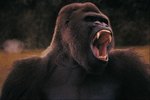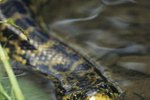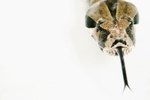
Though cobras vary slightly by species, these snakes generally are highly adapted to their environment. Cobras are well-equipped with physical adaptations allowing them to hunt, eat and defend themselves. Thanks to these traits, a cobra can live 20 to 30 years in the wild, effectively navigating his environment and earning his reputation as a formidable predator.
Warding Off Predators
When a would-be predator tries to pick a fight with a cobra, the snake stands up for himself. Cobras are known as "hooded snakes," as they are equipped with hoods around their heads that they can flare out at will. When the cobra feels threatened, he is able to stand upright, lifting the top third of his body straight up from the ground and flaring out his hood. In this position, he emits a loud hiss that sends a clear message to his opponent: Don't come any closer.
Deadly Venom
Sometimes, cobras can't avoid a fight, either with a predator like the mongoose or his prey. To deal with the dangers of his environment, the cobra is equipped with deadly venom that he emits from his fangs. In some cobras, like the king cobra, the venom is strong enough to bring down an animal as large as an elephant. Other cobras have adapted so that they don't even need to be within striking distance of their prey -- they're able to "spit" their venom with precision from distances as far as 8 feet, blinding their opponents.
Hunting and Eating
Because cobras hunt around dawn and dusk, they are adapted to rely on their sense of smell rather than sight when hunting. The snake's forked tongue effectively pulls scent particles into his mouth, where a special organ interprets the information. By flicking his tongue in and out, he can follow the scent trail of his prey. Once he's tracked and killed his prey, the cobra relies on his independent jaw bones (which all snakes have) in order to swallow his meals whole.
Versatile Traveler
Some cobras, like the Indian cobra, sport special adaptations that allow them to more safely navigate the environment. This snake in particular is marked by patterned, circular lines, creating an optical illusion that can make him difficult to see and identify in his natural habitat. Generally, all cobras are highly versatile in their natural habitats and are able to slither up trees, along high branches and through water with their developed, muscular bodies.
References
Photo Credits
-
Digital Vision/Digital Vision/Getty Images
Writer Bio
Tom Ryan is a freelance writer, editor and English tutor. He graduated from the University of Pittsburgh with a degree in English writing, and has also worked as an arts and entertainment reporter with "The Pitt News" and a public relations and advertising copywriter with the Carnegie Library of Pittsburgh.




